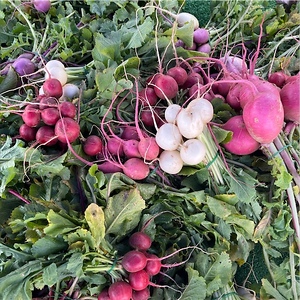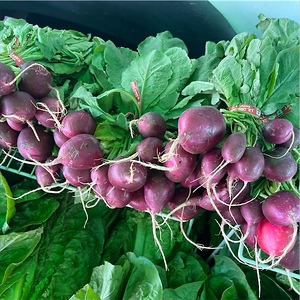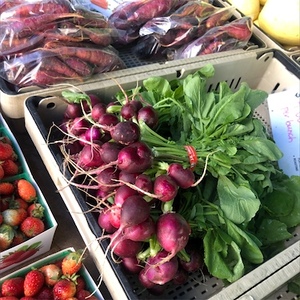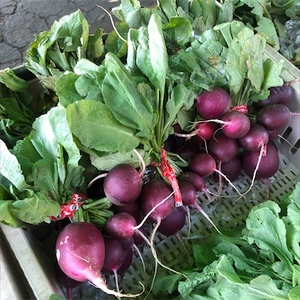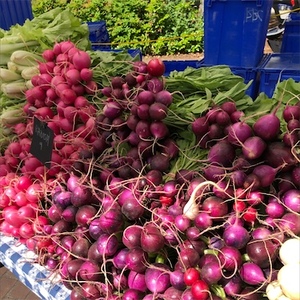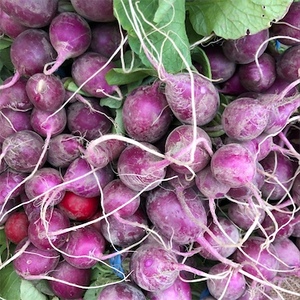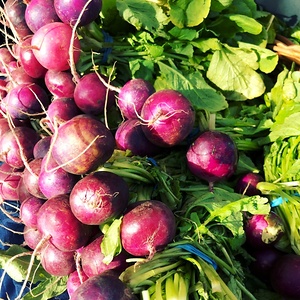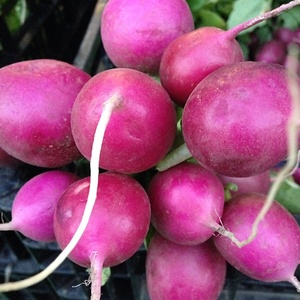


Amethyst Radish
Estimated Inventory, bunch : 0
Description/Taste
Amethyst radishes are small to medium roots, averaging 2 to 3 centimeters in diameter, and have a uniform, round shape with a narrow, thin taproot. The skin is firm, smooth, and thin, bearing a dark purple hue with a faint, metallic sheen. The taproot also showcases a dark purple coloring at the base, lightening into an ivory-white shade at the tip. Underneath the surface, the flesh is crisp, dense, white, and tender with a snap-like quality. Amethyst radishes have a mild, peppery flavor with subtle spiciness and earthy undertones. The green leaves and stems are also edible, contributing a vegetal taste, and generally range between 8 to 10 centimeters in length.
Seasons/Availability
Amethyst radishes are available year-round, with peak seasons in the spring and fall.
Current Facts
Amethyst radishes, botanically classified as Raphanus sativus, are edible roots belonging to the Brassicaceae family. The variety is a type of hybrid globe radish, a descriptor referencing the cultivar’s round appearance, and the roots are primarily grown as a home garden variety. Amethyst radishes are favored by gardeners, especially in Europe, for the root’s fast-growing nature, ability to be cultivated in containers and window boxes, and the versatility to harvest the radishes when young or left to mature for varying flavor and texture. The variety is also entirely edible, including the roots and leafy green tops. Amethyst radishes are valued by growers for their unique, colorful hues and provide an aesthetically pleasing color contrast with the white flesh in culinary dishes.
Nutritional Value
Amethyst radishes are a good source of dietary fiber to stimulate the digestive tract and vitamin C, an antioxidant that strengthens the immune system while reducing inflammation. Radishes also provide vitamin K to assist in faster wound healing, potassium to balance fluid levels within the body, and magnesium to regulate blood pressure. In addition to vitamins and minerals, radishes are believed to contain anti-fungal properties and have been used to promote overall respiratory and digestive health.
Applications
Amethyst radishes are a versatile root vegetable with a mild flavor well-suited for fresh, cooked, or pickled applications. The roots can be sliced thinly and eaten raw as a snack, tossed into green salads, stuffed into sandwiches, or spread across toast, covered in a layer of butter and salt as a mid-day meal. Amethyst radishes can also be chopped into salsas, used as a topping over tacos, mixed into grain bowls, or served whole on appetizer plates with creamy dips. In addition to raw preparations, Amethyst radishes can be incorporated into soups, roasted as a vegetable bed for meats, sauteed or stir-fried into noodle bowls, or cooked and stirred into pasta. Amethyst radishes can also be steamed, or they can be pickled as a salty, pungent condiment. Beyond the roots, the leafy green radish tops can be finely chopped into a pesto, sauteed and served as a side green, simmered into soups, or harvested when young as a tender microgreen. Amethyst radishes pair well with herbs such as tarragon, thyme, parsley, and cilantro, pea greens, arugula, aromatics, including scallions, chives, onions, and garlic, green beans, cucumbers, mushrooms, potatoes, fish, and nuts such as almonds, pine nuts, and walnuts. Whole Amethyst radishes should be separated from their green tops and stored in a plastic bag for 1 to 2 weeks in the refrigerator.
Ethnic/Cultural Info
Amethyst radishes were selected as one of the crops for the United Kingdom’s Royal Horticultural Society’s Award of Garden Merit in 2008. The uniform roots are recognized by the society for their easy-to-grow nature, compact size, mild flavor, and vibrant coloring. Amethyst radishes were also chosen as one of the varieties grown in the Kitchen Garden at the Royal Botanic Gardens in Kew. The Kew Gardens are one of the most extensive botanic gardens in London, established in the 1800s, and the gardens are a UNESCO World Heritage Site, a title given for land that is deemed culturally significant and worth preserving. There are over 50,000 plants within the gardens, and the Kitchen Garden is a working garden showcasing seasonal vegetables that can be grown in England. The Kitchen Garden is meant to inspire home gardeners to try growing different varieties that may be considered unusual. In addition to inspiring, the vegetables grown in the Kew Kitchen Garden, including Amethyst radishes, are also used at the botanic garden’s many restaurants to provide garden-to-table, fresh produce.
Geography/History
Radishes are believed to be native to regions of China, where the roots have been growing wild since ancient times. In the early ages, radishes were spread across Asia via trade routes and were introduced into Central Asia and the Mediterranean sometime before the 3rd century BCE. Radishes were extensively cultivated throughout Europe and Asia, developing many new varieties varying in flavor, appearance, and size, and there are many records of new radish varieties found among Roman, Greek, and Egyptian texts. Over time, smaller radish varieties, including globe radishes, were documented in Europe, and the garden varieties were later brought to the New World in the 16th century. Today Amethyst radishes are a favored variety in Europe, especially England, and are also grown in home gardens throughout the United States. The globe radishes can be found in seed form through online retailers and select garden stores, and full-grown radishes can be found at farmer’s markets through local growers.
Recipe Ideas
Recipes that include Amethyst Radish. One
| Epicurious |
|
Roasted Radishes with Brown Butter, Lemon and Radish Tops |



